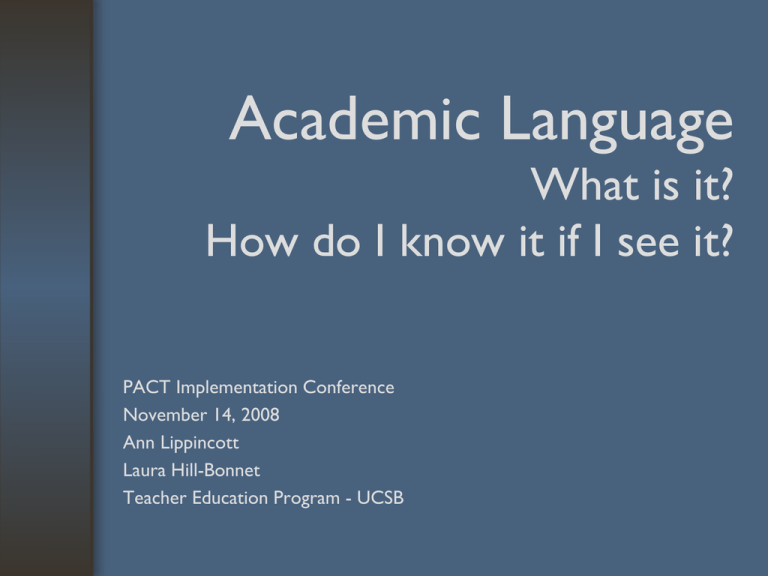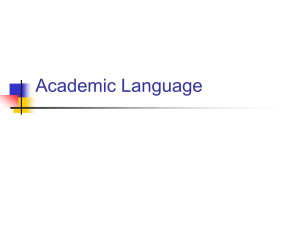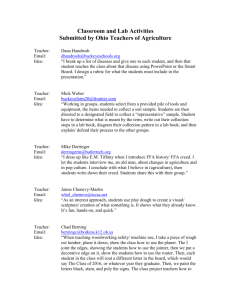Academic Language What is it? How do I know it if I see it?
advertisement

Academic Language What is it? How do I know it if I see it? PACT Implementation Conference November 14, 2008 Ann Lippincott Laura Hill-Bonnet Teacher Education Program - UCSB A story of epiphanies How we came to better understand academic language Epiphany 1 • We would ask professionals and policy makers “What do you mean by academic language?” • Typical response: “Well, you know…it’s the language needed for math and social studies.” • We argued that the language of math ≠ the language of social studies. • We also knew that how language is used in expository texts ≠ how language is used in narrative texts Therefore… • We began to think about how we could help teacher candidates realize that academic language is more than just content-specific vocabulary. • We also made efforts to ensure articulation across courses, quarters and instructors and in departmental professional development meetings. In early summer we ask teacher candidates Why is language used? How is language used? When/ Where/ With whom is language used? Later in summer we add Why is language used? Purposes How is language used? Grammar and Pronunciation When/ Where/ Communicative With whom is Competence language used? In fall quarter we introduce Why is language used? Purposes How is language used? Grammar and Pronunciation When/ Where/ Communicative With whom is Competence language used? Functions Forms Fluency Epiphany 2 • As we were calibrating PACT work with our colleagues, we had yet another epiphany. • We recognized that we, as a faculty, didn’t all agree on what academic language can/should look and sound like in classroom practice. • In fact, we had very different ideas about what constituted evidence of “academic language” as we analyzed PACT data together. Therefore… • We began to think about how we could facilitate consensus as to what constitutes evidence of “academic language” and what it can/should look and sound like in classroom practice. • Furthermore, we began to identify additional ways we could support teacher candidates vis-àvis our new ideas. • We decided to build upon a common language that would explicitly address our common knowledge. Functions, Forms & Fluency • Dutro & Moran (2003) introduce the notions of functions (tasks), forms (tools) and fluency (derived from opportunities to practice). • Provides an architectural metaphor that can be used in multiple contexts (instructional, supervisory, mentorship). Academic Language Functions • Functions (Dutro & Moran, pp. 232-233) – The tasks or purposes AND uses of language. – We use language to accomplish something in formal or informal settings, for social or academic purposes. – Social purposes include: exchanging greetings, expressing needs, making jokes, exchanging greetings, indicating agreement or disagreement, participating in personal conversations, etc. Academic Language Functions Dutro & Moran • • • • • • • • • • • Navigating written text Asking/answering informational questions Asking/answering clarifying questions Relating information Comparing and contrasting Explaining cause and effect Justifying and persuading Drawing conclusions Summarizing Evaluating Conducting research Academic Language Functions Chamot and O’Malley • • • • • • • • • • • Seek Information - use who, what, when, where, how Inform - recount information or retell Compare - explain graphic organizer showing contrast Order - describe timeline, continuum or cycle Classify - describe organizing principles Analyze - describe features or main idea Infer - generate hypotheses to suggest cause/outcomes Justify & Persuade - give evidence why “A” is important Solve Problems - describe problem-solving procedures Synthesize - summarize information cohesively Evaluate - identify criteria, explain priorities, etc. Language Function: Compare/Contrast Marine mammals Born alive Lungs Warm blooded Produce milk Excellent Swimmers Vertebrates Live in groups Ocean fish Born from eggs Gills Cold blooded Do not produce milk Academic Language Forms: Compare/Contrast • Sentence Frame: • ________ have __________, whereas________ have _____________. • Marine mammals have lungs, whereas ocean fish have gills. • Providing the mortar words will enable students to use language to compare and contrast. Social Studies • In social studies, long sentences with multiple embedded clauses are common. • Cause and effect statements are frequent. – Because there will be more people in the world in the future, we will need more land on which to build towns and cities. • Various verb forms are used: – “I found Rome a city of bricks and left it a city of marble.” Augustus is supposed to have spoken these words as he lay dying. He was Rome’s first emperor, and started the first of its great building programs. He claimed that he had had over 80 temples rebuilt. • Frequent use of pronouns it and they as referents. Mathematics • Comparatives: – 6 is greater than 4 – Maria earns six times as much as Peter – Lin is as old as Roberto • Prepositions: – (divided) into, divided by, – 2 multiplied by 6 and X exceeds 2 by 7 • Passive voice: – X is defined as a number greater than 7. • Reversals: The number a is five less than b. • Logical connectors: if…then – If a is positive then -a is negative. Science • Use of passive voice • Multiple embeddings • Long noun phrases serving as subjects or objects • If…then constructions • Logical connectors (if, because, however, consequently) Fluency (Dutro & Moran, p. 242) • The facility with which a speaker, reader and writer uses language. • Developed through focused and deliberate engagement with a range of uses of language (both oral and written), and many opportunities to practice the newly learned forms in different contexts. Epiphany 3 • We realized that the PACT Teaching Event could not be the only context which held teacher candidates responsible for academic language. • They needed practice and support across the various contexts in which they were developing as professional educators. Therefore… • We retooled our Lesson Design Frame to hold TCs accountable for addressing academic language in their practice. – Identify learning objectives – Identify academic language functions within learning objectives • Why K12 students are using language? – Identify corresponding forms • How K12 students are using language – Identify opportunities for students to express academic language • When, where and with whom they are using language Why…academic language? • Analyze learning activities and assessments to determine the appropriate academic language function(s) • Are K12 students – – – – – Making predictions Justifying Comparing/Contrasting Explaining Etc…. How…academic language? • Analyze academic language function(s) • What linguistic forms do K12 students need in order to – – – – – Make predictions Justify Compare/Contrast Explain Etc… When, where and with whom…? • Analyze learning activities for the opportunities they provide to use academic language • When, where and with whom do K12 students have opportunities to – – – – – Make predictions Justify Compare/Contrast Explain Etc… Future Epiphanies?? • If the lesson plan frame includes systematic opportunities to address academic language, then will the TCs be more systematic in their thinking about the needs of ELL students in the classroom? • We, as a faculty are in the process of examining opportunities for feedback for our TCs. Will we be systematic in our recognition of academic language in use in the K12 classroom?




